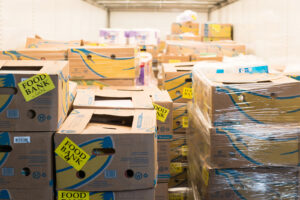May 13, 2025
In this post: Science of Methane Emissions | How Food Waste Creates Methane | Turning Methane into Renewable Energy | Renewable Energy Solutions for Unsold Food
Summary: When food is sent to a landfill, it creates methane emissions that contribute to climate change. This post explores the science of methane emissions created from food waste, and how to sustainably manage food so that methane can be captured and harnessed for renewable energy.
What if there was a way to turn a potent source of climate pollution into a climate solution?
Methane is a potent greenhouse gas that has roughly 80 times the warming power of carbon dioxide over the first 20 years. Wasted food is a major contributor to atmospheric methane; the EPA found that nearly 58% of methane emissions from municipal solid waste (MSW) landfills comes from wasted food.
Innovative solutions like Divert’s are harnessing the power of methane derived from unconsumed food to prevent waste and produce renewable energy at scale to power communities and protect the environment. In this blog, we’ll study why methane is so harmful to the environment, and how it can be captured for beneficial use.
The Science of Methane Emissions
Carbon dioxide is abundant, lasts in the atmosphere for hundreds to thousands of years, and absorbs heat in a wide range of wavelengths, except for atmospheric windows that allow heat to escape earth into space. While methane breaks down into less potent greenhouse gasses in the atmosphere much more quickly than carbon, it is disproportionately more potent because it traps heat in the atmospheric window, making it hard for the other gasses (like carbon) to escape. (Learn more about the relationship between methane and carbon.)
Methane’s potency and short-lived presence in the atmosphere make it an essential target for mitigating climate change. Reducing methane now can reduce atmospheric concentrations of greenhouse gasses within the next 20 years, which is critical to achieving net zero emissions by 2050.
The Role of Wasted Food in Methane Production
In the lifecycle of food production, there are upstream emissions created from the growing, manufacturing, and transporting of food, and downstream emissions from end-of-life-treatment. Upstream emissions account for the majority of a food product’s total environmental footprint, making waste prevention key to reducing food’s overall impact. Still, wasted food is the single largest stream of landfill waste at 24%. The U.S. wastes nearly 92 billion tons of food each year, resulting in millions of pounds of greenhouse gas emissions including methane. Waste diversion is therefore an essential step in reducing the downstream emissions from food.
How does wasted food emit methane?
- When food reaches the landfill, it gets mixed in with other materials (paper, textiles, plastics, and metals.)
- As that wasted food gets buried in landfill piles, it loses access to oxygen, creating an anaerobic environment.
- The nutrients and moisture from the wasted food interact with anaerobic microorganisms to create ideal conditions for methane-producing bacteria.
The sheer volume of food being wasted is causing harmful concentrations of methane in the atmosphere:
- Municipal solid waste (MSW) landfills are the third largest source of human-caused methane emissions (14%) after livestock (36%) and natural gas and petroleum systems (30%), according to the EPA.
- A 2020 study by the EPA revealed that wasted food causes 58% of methane emissions from MSW landfills. The same study also found that while total emissions from MSW landfills were decreasing, methane emissions from landfilled food waste were increasing.
Anaerobic Digestion: Harnessing Methane into Renewable Energy
When managed responsibly, methane is a valuable resource that can be put to good use rather than harming our environment. The same bio-chemical process of anaerobic digestion that happens in a landfill can take place in a controlled environment such as an anaerobic digester tank, where the resulting biogas can be fully captured. While landfills can capture some biogas, this biogas is often contaminated with air which makes it harder to clean and upgrade into renewable natural gas.
Biogas is the immediate gas produced by bacteria during anaerobic digestion. It is typically a mixture of methane (50-70%), carbon dioxide (30-50%) and some contaminants such as hydrogen sulfide, hydrogen, and water. When these contaminants are removed from the biogas, the resulting renewable natural gas (RNG) has the same molecular properties as fossil fuel derived geologic natural gas.
This RNG can be piped into local infrastructure, with multiple environmental benefits:
- Reduction of wasted food in landfills, where the water, nutrients, and energy potential are lost
- Prevention of further methane emissions
- Reduction of dependence on fossil fuels
Along with capturing biogas, anaerobic digestion reclaims the nutrients from food loss to produce digestate that can be recirculated into the food supply chain as an agricultural soil amendment. This process also reclaims the water from food loss, which can be exported to local treatment plants.
Innovating Renewable Energy Solutions from Unsold Food
At Divert, we’re scaling nationwide infrastructure to sustainably manage unsold food.
Through our holistic approach – Prevent, Provide, Power™ – we’re helping our customers prevent waste upstream, increase donations of edible food to local food banks, and transform non-donatable food into carbon negative renewable natural gas and digestate via our anaerobic digestion process.
With this strategy we’re not only helping our customers achieve their waste reduction and resource management goals, we’re delivering sustainable resources to the energy sector, such as our agreement with bp.
Are you ready to make a measurable impact on your waste reduction goals? Learn more about our solutions today.



